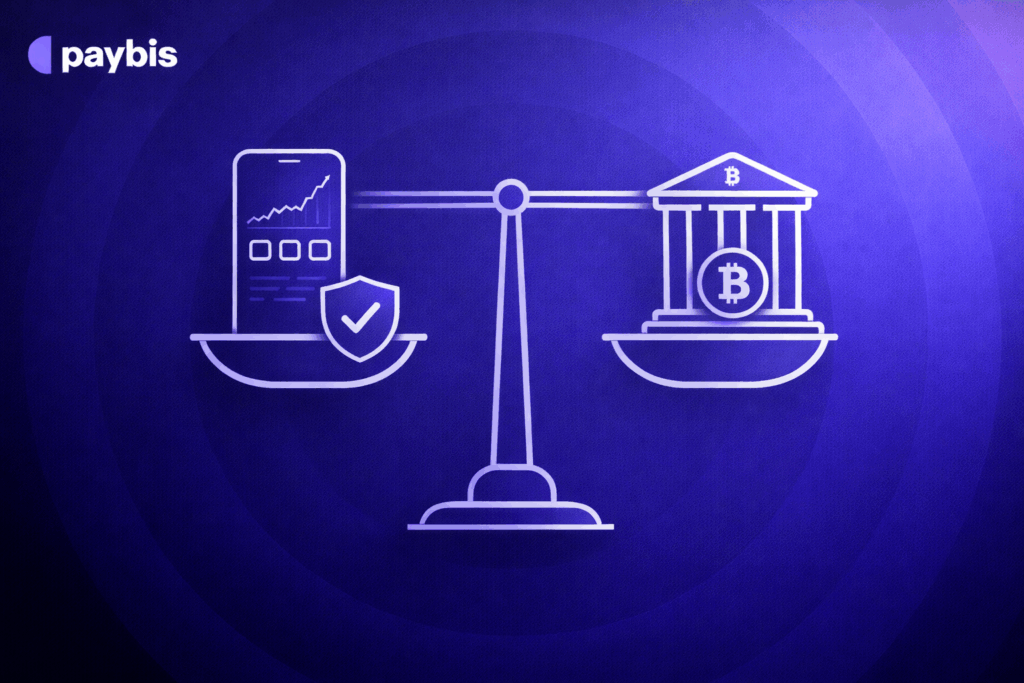Understanding Market Cycles in Crypto: Bull & Bear Market Patterns
Cryptocurrencies have always been known for their unpredictability, but 2025 is proving to be even more dynamic. After a rollercoaster ride of almost explosive bull runs and sharp bear declines, both crypto-savvy investors and early investors are reluctant to participate. And rightly so.
Understanding crypto market cycles, how they change, and what causes them is crucial for anyone who wants to enter the world of cryptos. While news outlets constantly publish flashy headlines with recent bull or bear market sentiments, beginners in crypto will likely find such articles lacking in terms of understanding the bigger picture.
We’re here to break down the bear and bull markets in simple terms, allowing you to be better informed in tracking the change indicators and making smarter decisions when acquiring cryptocurrencies.
Table of contents
Crypto Basics: What Are Crypto Market Cycles?
A market cycle is essentially a pattern of any asset’s value expansion and contraction, made evident by the rising and falling prices over time. The predictable nature of traditional assets makes it easy for virtually anyone to start investing varied amounts of personal funds and see returns, albeit in the long term.
Since traditional assets are typically backed by tangible and intangible entities like stocks, bonds, real estate, cash, and others, they provide intrinsic value, making traditional financial assets more secure. Additionally, traditional financial markets offer stability, established investment strategies, and market structures.
Crypto markets operate similarly, however, the main difference here is that cryptocurrencies are driven by extrinsic value, provided by market mood and sentiment. That’s why digital assets are much more volatile, making it difficult to predict price trends due to short-term price fluctuations.
- Intrinsic value: determined by an asset’s fundamental properties like company earnings, physical backing, or utility.
- Extrinsic value: determined by an asset’s external factors like market perception, brand reputation, or speculative demand (Bitcoin becoming known as “digital gold”).
Despite the differences between traditional markets and crypto markets, they both follow the same principles, namely supply and demand.
What Key Factors Influence Crypto Market Cycles?
As we already established, the value of nearly all cryptocurrencies is driven by extrinsic value, which is difficult to quantify and predict. Even so, there are specific tell-tale factors to keep in mind when tracking crypto cycles from bearish downfalls to unrelenting bull runs.
- Macro trends: Global economic conditions, institutional adoption, rising inflation, and interest rates impact many investors and their behavior.
- Liquidity: Inflows from institutional investors, venture capital, or retail traders can push prices higher, while liquidity crunches can cause declines.
- Investor sentiment: Market psychology is a major driver of crypto cycles with the fear of missing out fueling bull runs, and panic selling intensifying bear markets.
- Institutional involvement: Favorable regulations can trigger bullish sentiment, while bans or restrictive policies can lead to uncertainty and fear-driven sell-offs.
Bull Market
Epic bull runs are the reason why so many of us are becoming increasingly interested in cryptocurrencies and digital assets as a whole. Some of the most successful crypto investors like Matthew Roszak, Fred Ehrsam, Tim Draper, and many others have learned to time their investments for amazing returns and successful projects.
In short, a bull market is characterized by sustained price increases, often dictated by Bitcoin, which serves as an extra layer of confidence for most crypto investors. While market volatility is inevitable, when Bitcoin’s value starts to climb, often other cryptos follow.
The crypto value rise may seem sudden to most, however, the reality is that this process unfolds in several phases which experts track meticulously before investing.

Early Accumulation Phase
The first early accumulation phase is when crypto market analysts begin to see a recovery from a passing bear phase, although with caution. This is when institutional investors, hedge funds, and other high-net-worth individuals start to quietly buy assets at low prices.
Typically, media coverage and retail interest at this stage are low, allowing the big players to strategize their investments according to emerging market trends.
Expansion Phase
Once crypto prices start to steadily rise, attracting more traders and investors, the early accumulation phase turns to the expansion phase. Different media outlets begin to publish positive news, often talking about the many different technological developments of individual crypto projects and institutional adoption to attract more attention from less experienced traders. This is also when early investors begin to take an interest in cryptos.
Euphoria Phase
The most recent example of the crypto market entering a euphoria phase was when Bitcoin reached the famous $100K threshold in December 2024. As such, this phase begins with skyrocketing prices, often showing rapid and unsustainable gains.
The euphoria phase occurs when news coverage starts to peak, reporting on celebrity endorsements, and mainstream adoption, not unlike the news hype we saw in mid-January of 2025 when President Donald J. Trump not only spoke favorably of cryptos but also launched his own meme coin.
Distribution Phase
The final phase of the bull market is when all major investors start to take their profits, distributing their holdings to late retail entrants. As price movements become more and more erratic, volatility increases, resulting in sharp value drops and temporary increases.
The sudden price swings are followed by less optimistic news, although just as active as in the euphoria stage. Reporters and experts start to cover external factors like governmental regulations and macroeconomic shifts, all of which lead to uncertainty.
Bear Market
The end of the distribution phase signals selling pressure that begins to overtake buying demand, which in turn leads to a market correction process as the crypto market transitions into a bear market downturn.
A bear market is defined by significant price declines, negative market sentiment, and decreasing institutional investments as recorded by historical data. And just like with the bull market cycle, the bear cycle unfolds in distinct phases.

Distribution Phase
Bull and bear markets work in cycles and both these major shifts influence one another. This is why the distribution phase signifies the end of the bull market and the start of the bear cycle.
Specifically, when the bull market starts to peak and the market begins to show signs of declining prices, early profit-takers exit the markets with their earnings as investor confidence drops. Some investors remain in hopes of buying the dip, but both the market sentiment and media coverage remain doubtful as trading volumes decrease.
Capitulation Phase
As the name suggests, the capitulation phase is signified by a sharp decline in digital asset prices with fear and uncertainty dominating the market amidst panic selling. Furthermore, leverage starts to roll out as overextended traders face liquidations, accelerating the decline.
With the negative wave, propelled by decreasing market sentiment, many retail investors sell at a loss or leave the market entirely. Social media and self-made experts often predict the “end” of crypto, yet interestingly enough, some crypto traders like David Foster have taken advantage of bearish situations to land some of the best long-term buying opportunities.
Accumulation Phase
After the big and usually over-hyped crypto sentiments die down, often reaching rock bottom, crypto prices start to stabilize. Smart money begins re-accumulating, but retail participation remains low due to lingering pessimism.
While the overall volatility and negative sentiment remain, trading volumes slightly shift, reflecting a hopeful atmosphere for early signs of cryptocurrency market cycle recovery. The accumulation phase also plays a key role in setting the foundation for future crypto market cycles, though this may take anywhere from months to years.
Navigating crypto market cycles and understanding how thet affect cryptocurrencies and their ever-changing value is one thing. But knowing how to find your way around these cycles to review market conditions for the best time to trade cryptos is another challenge altogether.
In the following section, we’ll go over the most common strategies you can learn to help plan your investments to ensure asset value protection. Please note that the information provided is for educational purposes and doesn’t constitute any investment advice.
Bull Market Strategies: Avoiding FOMO
Whether you’re new to crypto or you’re an experienced trader, one thing that gets all of our attention are the myriad of relentless headlines announcing bull market rising prices. This is often backed with incredible success stories, and in-depth review pieces on the technological advancements of blockchain projects in decentralized finance and other sectors.
While it’s all well and good, this can also cause a massive fear of missing out (FOMO for short), which too many people experience with negative outcomes. Here are a few things to keep in mind:
- Take profits gradually: Consider scaling out as crypto prices begin to rise rather than always aiming for the absolute top. A good example here would be to use the laddered exit strategy to help lock in gains without completely removing yourself from participation in the crypto market.
- Manage risk: As hype builds, traders often increase leverage, leading to higher liquidation risks. Sticking to proper position sizing and avoiding excessive leverage can help prevent major losses.
- Don’t give in to FOMO: Euphoria-driven buying near market tops can lead to less desirable results. Massive price surges are certainly appealing, but researching promising projects can lead to higher-quality and long-term investments.
A laddered exit strategy involves gradually selling portions of an asset at different price levels to lock in profits while maintaining activity for potential future gains.
Bear Market Strategies: The Potential of Undervalued Projects
Just like epic bull runs increase community hype, bearish winters scare away traders as crypto prices plummet. These examples only go to show just how much influence community and media sentiment can have on market trends.
Caution is always advised, but when it comes to following these trends, it’s always best to critically evaluate the situation from an individual perspective. Some of the best practices to follow are:
- Dollar-cost averaging (DCA): Instead of trying to time the exact bottom, consider gradually accumulating assets at lower prices to reduce risk and improve long-term returns.
- Staking & yield farming: Cryptocurrencies are defined by their volatility, but locking assets in staking protocols or yield farming can help generate passive income during downturns.
- Identify undervalued projects: Bear markets offer a chance to buy strong projects at lower prices, so researching promising projects, their creators, and developers can help pinpoint the best projects for you.
Timing the Market vs. Time in the Market
- Timing the market (trying to buy low and sell high). This is when traders attempt to capitalize on short-term price movements. However, this process is difficult as short-term predictions for crypto prices is extremely unpredictable, resulting in some investors selling too early or buying too late.
- Time in the market (long-term investing). This strategy has historically proven to be more effective where investors hold strong assets through multiple market cycles, leading to substantial returns.
Conclusion
Stepping into a world of crypto is certainly exciting, but participating in it requires not only experience but also knowledge. With over a decade of experience working in crypto, Paybis emphasizes the importance of research and credible information. That’s why we endeavor to explain the many different aspects of crypto so you can feel better equipped to start your crypto journey.
FAQ
How long do crypto bull cycles last?
It depends. Typically, a bull run cycle can last from several months to more than a year. According to historical data, the period of rising prices can last anywhere from 6 to 18 months, which is heavily influenced by market trends, sentiment, and other macroeconomic factors.
How long does a crypto bear market last?
Just like with bull markets, a bear market can last between a few months to over a year. For example, the 2013–2015 bear market lasted for around 415 days.
Why does crypto jump every 4 years?
Bitcoin is the driving force behind nearly every major shift in the crypto markets. Every four years, Bitcoin undergoes a halving event during which the existing value per block is halved. Historically, these block reward reductions with sustained or increased demand, have led to crypto price surges.
Disclaimer: Don’t invest unless you’re prepared to lose all the money you invest. This is a high‑risk investment and you should not expect to be protected if something goes wrong. Take 2 mins to learn more at: https://go.payb.is/FCA-Info



